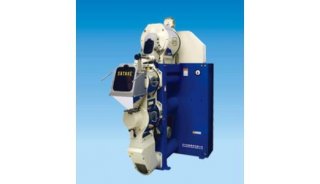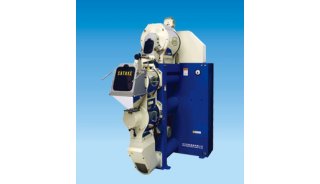Appendix G: Spectrophotometry

Figure G.1 Electromagnetic Radiation Spectrum

Figure G.2. Schematic light transmission

Figure G.3. Use of the Spec 20
A spectrophotometer or colorimeter makes use of the transmission of light through a solution to determine the concentration of a solute within the solution. A spectrophtometer differs from a colorimeter in the manner in which light is separated into its component wavelengths. A spectrophotometer uses a prism to separate light and a colorimeter uses filters.
Both are based on a simple design of passing light of a known wavelength through a sample and measuring the amount of light energy that is transmitted. This is accomplished by placing a photocell on the other side of the sample. All molecules absorb radiant energy at one wavelength of another. Those that absorb energy from within the visible spectrum are known as pigments. Proteins and nucleic acids absorb light in the ultraviolet range. The following figure demonstrates the radiant energy spectrum with an indication of molecules which absorb in various regions of that spectrum.
The design of the single beam spectrophotometer involves a light source, a prism, a sample holder and a photocell. Connected to each are the appropriate electrical or mechanical systems to control the illuminating intensity, the wavelength, and for conversion of energy received at the photocell into a voltage fluctuation. The voltage fluctuation is then displayed on a meter scale, is displayed digitally, or is recorded via connection to a computer for later investigation.
Spectrophotometers are useful because of the relation of intensity of color in a sample and its relation to the amount of solute within the sample. For example, if you use a solution of red food coloring in water, and measure the amount of blue light absorbed when it passes through the solution, a measureable voltage fluctuation can be induced in a photocell on the opposite side. If now the solution of red dye is diluted in half by the addition of water, the color will be approximately 1/2 as intense and the voltage generated on the photocell will be approximately half as great. Thus, there is a relationship between the voltage and the amount of dye in the sample.
Given the geometry of a spectrophotometer, what is actually measured at the photocell is the amount of light energy which arrives at the cell. The voltage meter is reading the amount of light TRANSMITTED to the photocell. Light transmission is not a linear function, but is rather an exponential function. That is why the solution was APPROXIMATELY half as intense when viewed in its diluted form.
We can however monitor the transmission level and convert it to a percentage of the amount transmitted when no dye is present. Thus, if 1/2 the light is transmitted, we can say that the solution has a 50% Transmittance. Note that it is always relative to a solution containing no dye.
Transmittance is the relative percent of light passed through the sample.
What makes all of this easy to use, however, is the conversion of that information from a percent transmittance to an inverse log function known as the Absorbance (or Optical Density).
The Beer-Lambert Law
Definiton
Absorbance: The negative log

 of the transmittance.
of the transmittance.
A = - logT EQUATION G.1
This value is more useful in spectrophotometry than transmittance, because of plot of absorbance vs concentration yields a straight line. A plot of transmittance vs concentration is an exponential. The - log calculates the inverse of transmittance, so that absorbance increases with increasing concentration. Transmittance would decrease as we increased the amount of red dye in our example. The relationship of Absorbance to concentration was shown by two biochemists to follow the equation for a straight line, y = mx +b, where m is the slope of the line and b is the y intercept. If the measurement is made in such a way that b = 0 (that is, a solution containing no dye has no absorbance), and if we substitute Absorbance for y, concentration for x, and variant for m, we arrive at the formulation of the Beer-Lambert Law:
A = C where A = absorbance C = concentration = the extinction coefficient
Note that variant is equal to the slope of the straight line which will result from a plot of absorbance (y axis) vs concentration (x axis).
To use a spectrophotometer it is necessary to establish a known series of dilutions containing known quantities of a solute. One of these will contain no solute and is known as the blank . It is used to adjust the instrument to read 100% transmittance or 0 absorbance. In use, a 0% transmittance value (infinite absorbance) is established by placing a curtain between the light source and the photocell. Electronic control is then exerted so that the meter will read 0% Transmittance on its scale. The blank sample (containing no solute or dye) is inserted, the curtain opened and the meter readjusted to read 100% transmittance. All other measures are then made by merely inserting the samples into the light path and measuring the % transmittance. Most spectrophotometers have a built in means of direct conversion of this reading to absorbance.
After recording the absorbance for a series of standards, a plot is made of the absorbance value (y axis) vs the concentration (x axis). The slope of the line is the extinction coefficient.
Note that this may be computed directly by rearrangement of the Beer-Lambert law to
= A/C EQUATION G.2
This value can be calculated for each reading and the average taken as the value of variant. Remember that this value is a constant. Thus, once calculated, it can subsequently be used to determine an unknown concentration by one more rearrangement of the Beer-Lambert law
C = A/ EQUATION G.3
Any measured value of A can be readily converted to a corresponding concentration merely by dividing the absorbance by  .
.
The use of the Beer-Lambert law is easy to visualize with red food coloring. It is not as easy to visualize, but none the less, just as accurate to measure wavelengths of light which are not visible. Either infra red or ultraviolet can be used. UV is more useful to biologists since many molecules (all proteins and nucleic acids) absorb ultraviolet light. The only changes that need to be made is the use of quartz cuvettes instead of glass tubes. Glass absorbs UV light and thus is inappropriate for use in a UV spectrophotometer. An instrument capable of using visible light (usually with a tungsten or halogen lamp source) and UV light is known as a UV/Vis Spectrophotometer.
OPERATION OF B&L SPEC. 20
The most commonly encountered spectrophotometer is one manufactured by Bausch and Lomb and known as the Spec 20. The 20 refers to the band size of light that it is capable of producing. If the instrument is adjust to a wavelength of 730, for example, it actually transmits light from 720 nm to 740 nm. Thus, it is not as precise or refined as instruments designed for research purposes where the wavelength may be controlled to a fraction of a nanometer. It is, however, the standard workhorse instrument found in nearly every lab.
Turn on the spectrophotometer and allow 10 minutes for warm up of the instrument before use.
Adjust the wavelength to that specificied for the procedure you are using.
Be sure the cover is closed on the cuvette holder and use the left knob on the front panel to adjust the dark current such that the meter is reading 0 transmittance. At this point, you are simply adjusting the internal electronics of the instrument to blank out any residual currents. This adjusts the lower limit of measurements. It establishes that no light is equivalent to 0 transmittance or infinite absorbance.
Insert a clean cuvette containing the blank into the holder. Be sure that the tube is clean, free of finger prints and that the painted line marker on the tube is aligned with the mark on the tube holder. Close the top of the tube holder. The blank for this exercise is the solution containing no dopachrome, but all other chemicals. The amount of solution placed in the cuvette is not important, but is usually about 5 ml. It should approximately reach the bottom of the logo printed on the side of the cuvette.
Adjust the meter to read 100% transmittance, using the right knob on the front of the instrument. This adjusts the instrument to read the upper limit of the measurements and establishes that your blank will give a reading of 100% transmittance (0 absorbance).
Remove the blank from the instrument and recheck that your 0 transmittance value has not changed. If it does, wait a few minutes for the instrument to stabilize and redo steps 1-5. Periodically throughout the exercise, check that calibration of the instrument is stable by re-inserting the blank and checking that the 0 and 100% T values are maintained.
To read a sample, simply insert a cuvette holding your test solution and close the cover. Read the transmittance value directly on the scale.
Record the % transmittance of your solution, remove the test tube cuvette and continue to read and record any other solutions you may have.
It is possible to read the absorbance directly, but with an analog meter (as opposed to a digital read out), absorbance estimations are less accurate and more difficult than reading transmittance. Absorbance can be easily calculated from the transmittance value. Be sure that you note which value you measure!




















